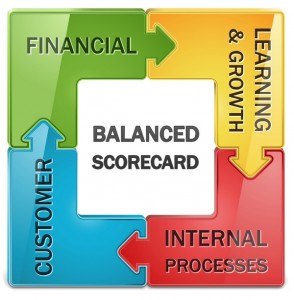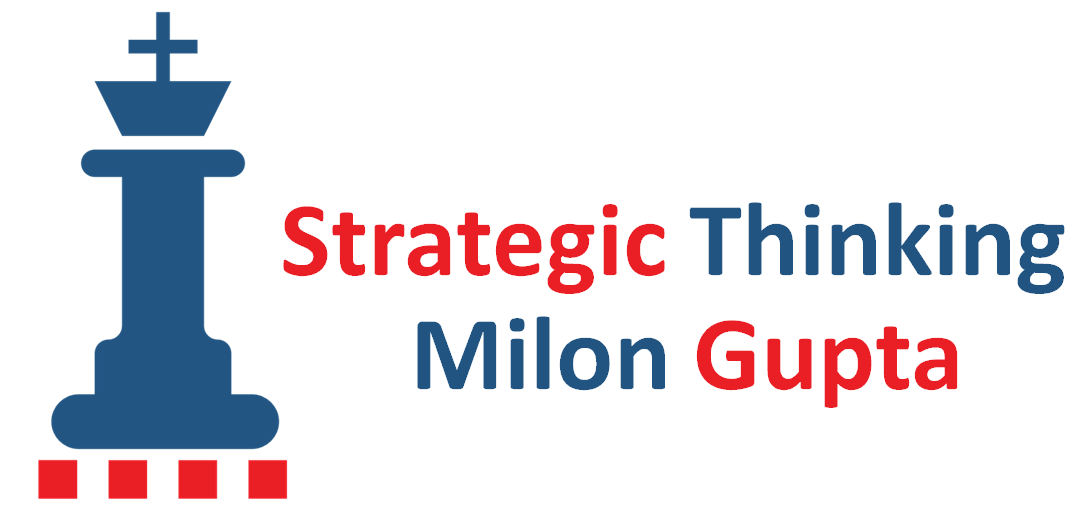One of the most popular tools for strategy implementation is the Balanced Scorecard (BSC). More than two decades after it was presented to the public by Robert S. Kaplan and David P. Norton in 1992, the BSC has turned out to be one of the most popular management tools, which is not only used by private companies, but also by public institutions and non-governmental organizations.
Balanced Scorecard in a nutshell

One of the reasons for the popularity of BSC has been its apparent simplicity combined with its holistic perspective on business beyond finance. The original core concept is based on four perspectives:
- Financial
- Customer
- Internal processes
- Learning and growth
These perspectives are meant to be of equal importance, hence the word ‘balanced’ in BSC. The concept is based on closed-loop control, a fundamental concept from cybernetics, where actual performance is measured, the measured value is compared to a target value, and based on the difference between the two corrective action is taken.
For each perspective, objectives, measurements, targets, and initiatives for achieving these targets are defined. In the late 1990s, Kaplan and Norton complemented the concept by adding the Strategy Map, which is a graphical representation of the strategic objectives for each of the four perspectives and their relationships.
As simple and convincing as the expanded BSC concept appears, the actual outcomes and experiences have been of mixed quality. Some companies achieved measurable benefits, while others failed and sometimes even abandoned BSC in frustration. However, the failures have not necessarily been the fault of the BSC, but were usually caused either by inadequate strategic objectives, ill-defined measures, or avoidable mistakes in implementing the BSC.
The three most common mistakes in BSC implementation
1. Lack of balance between perspectives
Visually presenting the four perspectives as balanced does not necessarily mean that they are balanced in practice. There is a risk that the financial perspective gets too much weight, as it is tempting to let short-term financial objectives dominate the other three perspectives. Especially the last two perspectives “Internal process” and “Learning and growth” usually don’t have a measurable impact on the bottom-line in the short-term. However, for the achievement of strategic objectives and sustainable business success maintaining the balance against short-term temptations is crucial.
2. Unthoughtful use of standard perspectives, objectives, and measures
Starting from the four classical perspectives ‘Financial’, ‘Customer’, ‘Internal processes’, and ‘Learning and growth’ is certainly a good way to approach BSC implementation. However, this should not lead to a mechanical, unthoughtful adoption of these perspectives. Instead, there should be a specific reflection of the organization’s strategy and strategic objectives in order to determine, how to define the perspectives. The concept is flexible enough to allow less or more perspectives.
The four classical perspectives, and variations thereof, have been proven as useful and generic enough. But that doesn’t mean, it is also the perfect choice for your organization. And even, if you end up with these four, it would be important to go through a deep strategic conversation process, in order to have a clear and shared understanding on how these perspectives are used, especially how they are related your organization’s strategic objectives. In the same way, it is crucial to spend some thought on the choice of measures and targets for each perspective.
3. Confusing Balanced Scorecard with strategy setting
The Balanced Scorecard is a tool for strategy implementation. It translates an organization’s vision and strategy into measurable objectives, links them to individual performance in different areas, and creates a feedback loop which allows to adjust objectives accordingly. However, BSC is not a tool designed for strategy setting. Instead, the effectiveness of BSC-based strategy implementation depends on the quality of the strategy-setting process and the strategic objectives emerging from the process. In other words, if the strategy and the strategic objectives are inadequate, even the best BSC implementation is not very likely to contribute to successful strategy implementation and sustained success of the organization.
Conclusion
More than two decades after its introduction, the Balanced Scorecard is still one of the most effective tools for strategy implementation. In order to reap its full benefits, organizations need to have a clear strategy-setting process in place that leads to adequate strategic objectives. As long as an organization implements BSC in a deliberate way and with full commitment by its leadership, there is a high likelihood that BSC will contribute to long-term success.
Against a still widespread prejudice, the Balanced Scorecard can also be implemented in small businesses, despite their usually tight resource constraints. Thus, the Balanced Scorecard can be a major tool for the strategic management for organizations of all types and sizes.
